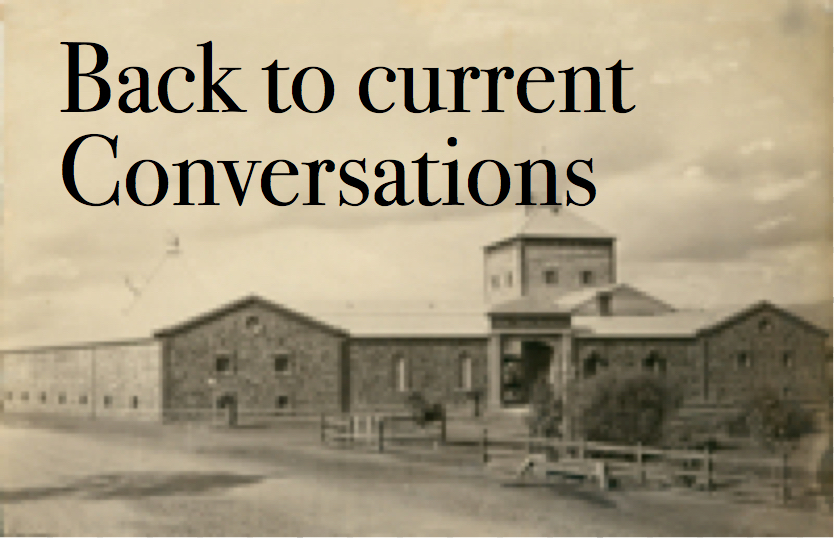

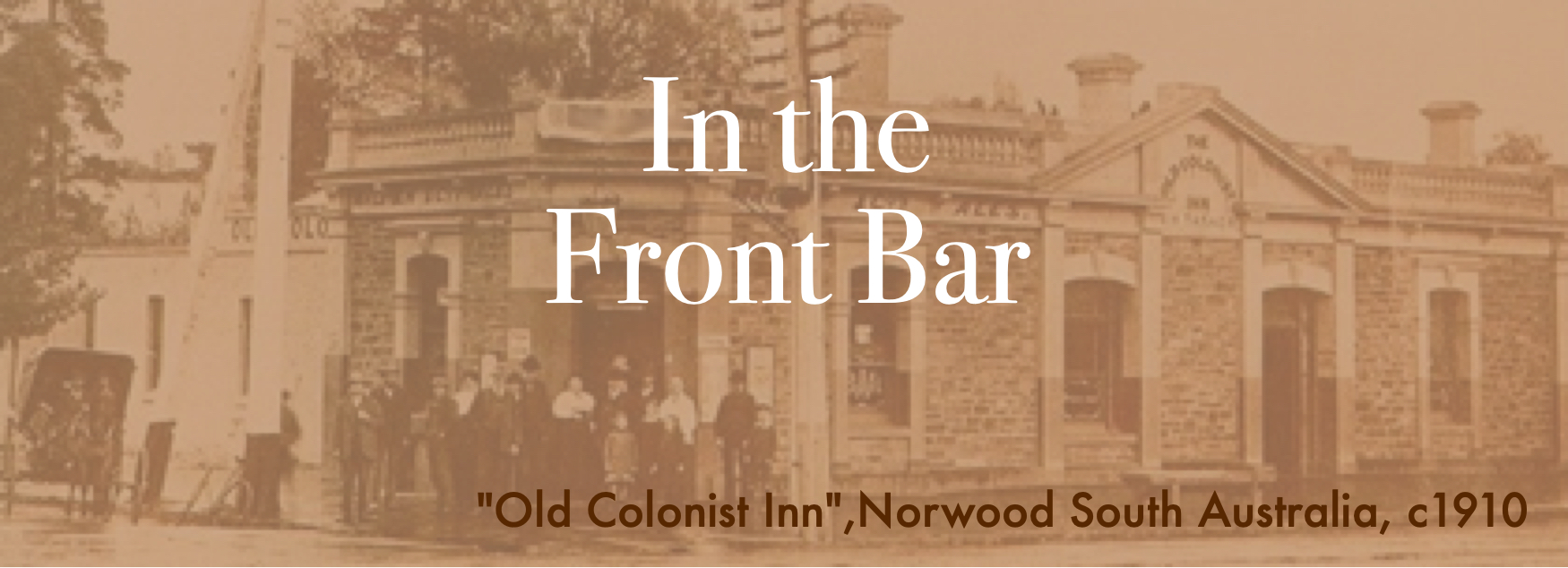
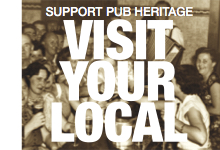
To IPA or not to "I" the PA, or should that be an "A" question?
Questioning whether the myth really is a myth - and in the process getting himself into all sorts of historical and logical trouble - D J Spiers summarised the essentials of the IPA Myth:
"Beer brewers were looking for a beer to take to India. The trip to India is hard on beer, since the beer is exposed to dramatically high temperatures including crossing the equator twice and a very long journey over time and distance.... George Hodgson of the Bow Brewery stepped up with his variation of the popular pale ale. He increased the gravity of the pale ale beer (high alcohol) and added a ton of hops (highly hopped). This new creation not only survived the trip to India, it seemed to improve the beer. The India Pale Ale style was born."
While acknowledging that nineteenth century IPA undoubtedly had something to do with Hodgson's Bow Brewery and exporting ale to India, the more critical and serious historical research of (in alphabetic order) Pete Brown, Martyn Cornell, Ron Pattinson, and Mitch Steele challenges this simple explanation and suggests that the origin and development of IPA was more complex and interesting. This bigger story includes the following:
- Contrary to the assumption that the Indian climate effectively prevented it, beer was brewed in India from at least 1855; by the 1890s, at least half of the local beer was sold to the British Army Commissariat.
Admittedly significant quantities of beer were imported from Britain but the main customers for this expensive "IPA" were the middle and upper-middle classes of the Raj. The quantity of "IPA" exported to India
by Hodgson and other brewers was small both absolutely and by comparison to the quantity of porter which remained the beer of choice for majority of British in India, mostly soldiers.
(See soon under Projects for my research into the quantity of porter, stout and ale imported into South Australlia).
- From at least the last decades of the eighteenth century and increasingly from 1823, Hodgson's was not the only brewery exporting beer generally and pale ale specifically
to India (as well as the other pink bits of the map, including Australia). What's more, despite being preferred by some, Hodgson's pale ale was not universally celebrated and,
by the first decades of the nineteenth century, had been eclipsed by other brewers' pale ales, some of which were called "East India Pale Ales" or similar, and some of which
were called simply "Pale Ales".
- The opening of the Suez Canal at the end of 1869, the extension of rail networks connected to major ports throughout Europe and the development of shipping companies such as P&O, dramatically shortened the voyage to India.
At about the time, then, that IPA was apparently at the height of its popularity amongst the British imperialists in India, there wasn't such a great need for a beer that could withstand the rigours
of sailing around the Cape of Good Hope.
- Supposedly strong, bitter ales of the type that would be called "India Pale Ale" were not new in the late eighteenth and nineteenth century Britain. And, what's more,
according to the data provided especially by Ron Pattinson and Mitch Steele, the characteristics (OG, FG, Apparent Attenuation, ABV and Est IBU) of nineteenth century IPAs exhibit high variability
and fall within the range of "Pale ales" or similar (such as October beer, Stock beer, Bitter Ale, Mild Ale, and Strong Ale) including those that were brewed for local consumption rather than export and
were not called India Pale Ale. India Pale Ale did not represent a well-defined "style", let alone a beer designed specifically to survive the journey to India and then to appeal to British palates.
Which isn't to deny that "India Pale Ale" existed or that, in general, IPAs tended to be stronger and hoppier/bitter (relatively high ABVs and IBUs) than other contemporary non-Indian pale ales
as Pete Brown has argued, it's just that the India(n) prefix was more likely to have been about
marketing in an increasingly competitive environment than the beer itself*.
"What's the difference between IPA and PA? I suspect it may be even less than the difference between Porter and Stout.... maybe there isn't really a difference between the two. Why was IPA given its name? To let you know that is was a Pale Ale prepared for the Indian market, which is how it was originally referred to. No doubt to differentiate it from 18th-century style Pale Ale, which is a completely different beast, with few hops and really a Light Mild. As the 19th-century progressed and old-style Pale Ale disappeared, there was no longer a need to warn drinkers that this was the heavily-hopped type of Pale Ale. That's the only Pale Ale there was. So the India bit mostly got dropped from the name...
The longer I study beer styles, the fewer different ones I find. Mild, PA, Porter, Strong Ale, Brown Ale. That's about it really."
Another great British beer historian, Martyn Cornell comes to a similar conclusion: "I would suggest, that India Pale Ale was seen as merely a subset of pale ale, the kind "as prepared for India" rather than something completely different". Thank you, Ron and Martyn.
And just to add something local into the argument:
An Australian connection
The same issues that applied to exporting British beer to India also applied to other British colonies, and no more so than Australia - at least until the various colonies enjoyed sufficiently developed brewing industries that could supply the local market. Even then the Australian colonies imported relatively large quantities of both cask and bottled British beer until well into the nineteenth century. (Ron Pattinson has shown that, despite higher pricing, Australia was a relatively close second to the Indian market for British beer exports, at least until the mid-1860s.)
(Added to this (and often overlooked), shipments to the Australian colonies were not all that frequent and were seasonal/weather dependent; imported beer might have to be stored for some time before stocks could be replenished. Beers with a reputation for keeping in not exactly cool colonial cellars would have been preferred.)
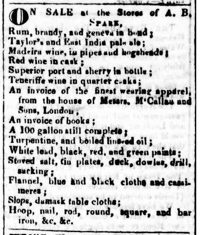
|
It's not completely surprising therefore that, as the Foods of England Project and
Martyn Cornell's research has shown,
the first recorded use of the term "India Pale Ale" was not in the manifests of East India Company clippers nor in the Calcutta Gazette as we might expect,
but in a newspaper advertisement in the Sydney Gazette and New South Wales Advertiser for 27 August 1829 (Left).
This "East India Pale ale" was brewed, not by Hodgson's Bow Brewery nor Allsopp's, nor by Bass' or any of the usual contenders, but by "Taylor's", which was, as Martyn Cornell pointed out, almost undoubtedly Taylor Walker's, also a Thames-side London brewery with as ready access to the docks as Hodgson's. |
So, in Australia at least, something appears to have happened between 1819 and 1829 and I suspect that was the expansion and globalisation of the brewing industry in Britain, increased competition between brewing companies and the increasing perceived need for 'product differentiation' ie marketing. As again Martin Cornell has suggested "the "East India pale ale" designation was strictly a retailer's usage, in Australia, and not one used by the brewers themselves, or even by the shippers." Or perhaps someone just chalked "India" on a barrel of Pale Ale being loaded on an East India Company ship...
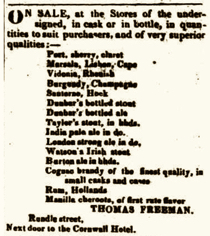
|
For the record, the first reference to pale ale in South Australian newspapers was in the South Australian Gazette and Colonial Register for 3 March 1838.
The first named pale ale, Allsop's [sic], followed soon after in the Southern Australian for 2 June 1838. The first advertisement for Hodgson's ale - Indian or otherwise -
was in the Southern Australian for 11 September 1839. And the first reference to India Pale Ale was in the Southern Australian for 16 January 1840 (left); the
brewery was not named but was probably Taylor's.
|
Another Australian connection: Australian Pale Ale!
India was not the only geography to be involved in the confusion around the name and nature of nineteenth century ales. British breweries produced and exported at least two IPA-like beers called "Australia Pale Ale" and "Sydney Ale" respectively.
As Martyn Cornell has yet again pointed out (and many thanks to Ron Pattinson for the initial hint):
"The very first mention of the term 'bitter beer' in The Times comes on September 5 1842, in a small advertisement for 'Ashby's Australian Pale Ale', which 'is the most pleasant of all the different sorts of bitter beer that we have ever tasted', according to a newspaper quoted in the ad. So the first time we find bitter beer being mentioned, it is as a synonym for pale ale.
Ashby's Australian Pale Ale was made by the Quaker-founded Ashby's brewery in Staines, Middlesex, a few miles up the Thames from London. A later advertisement, from the following year, showed Ashby's had been exporting it to the Australian colonies since 1829 and the beer 'resembles the East India pale ale in flavour and colour, with rather more body.'"
According to Martyn Cornell's investigations into "the mysterious Australian Ale", this version of (I)PA seems to have had a provenance as old as named India Pale Ale. Australian Ale "appears to be a name given to "No 3" grade Burton Ale, 1080 to 1085 OG or so, around 7 or 8 per cent alcohol, stronger and, probably, slightly darker and rather sweeter than a [British] Victorian IPA would have been" but still within the range of characteristics of Pale Ales - admittedly perhaps more towards the Strong and perhaps Scottish end of the spectrum?
The Ashby Staines Brewery also advertised in Australia. "Ashby's Ale" appeared in the Sydney Gazette and New South Wales Advertiser on 19 September 1829 and "Ashby's Strong Ale" from 7 December 1830. "Ashby's Australian Ale" is mentioned somewhat later, in the Sydney Morning Herald for 20 August 1850.
Just to confuse things even more, on 18 April 1856 the Burton Brewery Company advertised an Australian Ale in The [Melbourne] Age (below), implying that "Australian Ale" was not just an Ashby brand but a generic (pale) ale that fitted somewhere along the Bitter-India-Pale Ale spectrum.
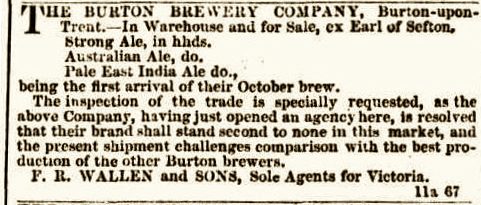
And there was also at least a "Sydney Ale" which seems to have been somewhere between an Indian [Pale} Ale and a Barley Wine. On 12 July 1847 the Sydney Morning Herald advertised the sale of Allsopp's Sydney Ale. The only other reference to Sydney Ale that I have able to find is over five years later (so it can't be the same shipment) in the Adelaide Times (below) and other South Australian newspapers from 14 July 1854 through to May 1855; although named as "Allsopp's Celebrated Sydney Ale", this is also described as "Allsopp's Indian Ale" and compared to "Wine of Malt", and therefore to possibly Barley Wine or Strong Ale.
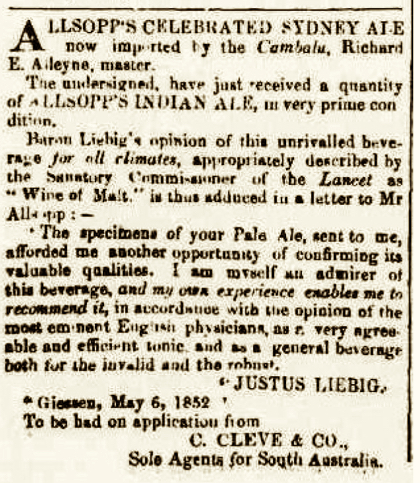
Exactly what were these antipodean-bound ales and how they might or might not have related to nineteenth century IPAs, we don't know. It seems that there's more work yet to do especially on the "Sydney Ale" and perhaps other British-brewed, Australia-named beers.
Time for a refill...
Selected references
Pete Brown (2008), Hops and Glory: One man's search for the beer that built the British Empire
Pete Brown, "India Pale Ale", Oxford Companion to Beer (2011), reprinted in Craft Beer & Brewing Magazine
Pete Brown, "George Hodgson", Oxford Companion to Beer (2011), reprinted in Craft Beer & Brewing Magazine
Pete Brown, "A Quick Blog Post for IPA Day" (2017) and "Burton IPAs arrival in India" (2016) in Pete Brown's Blog Archive
Martin Cornell (2010), Amber, Gold & Black: The History of Britain's Great Beers
Martin Cornell (2007), "The mysterious Australian Ale" in his Zythophile blog, 23 August 2007
Martin Cornell (2008), "IPA: much later than you think [Part 1]" in his Zythophile blog, 19 November 2008
Martin Cornell (2008), "IPA: much later than you think [Part 2]" in his Zythophile blog, 19 November 2008
Martin Cornell (2010), "The first ever reference to IPA" in his Zythophile blog, 29 March 2010
Martin Cornell (2010), "IPA: the executive summary" in his Zythophile blog, 31 March 2010
Martin Cornell (2011), "Four IPA myths that need to be stamped out for #IPADAY" in his Zythophile blog, 4 August 2011
Martin Cornell (2013), "The earliest use of the term India Pale Ale was... in Australia?" in his Zythophile blog, 14 May 2013
Ron Pattinson (2014), Bitter!
Ron Pattinson's blog, Shut up about Barclay Perkins includes numerous references to India--sh Pale-ish Ales - really worth consulting.
Mitch Steele (2012) IPA: Brewing Techniques, Recipes and the Evolution of India Pale Ale
Peter Symons (2015), Bronzed Brews
Peter Symons (2015), Six O'clock Brews
*[Apologies for the footnote] Although there is absolutely no evidence for this that I can find, it's possible that the "India" in "IPA" might have come from the late Georgian and Victorian British obsession with India and things Raj-ian, from architecture to literature, textiles and wallpaper and to food and drink. Otherwise, why not just "Export" Pale Ale or "British Imperial" Pale Ale. At the same time as the English apparently discovered IPA, they also discovered curry: the first curry recipe was published in 1747; the first advertisement for curry powder appeared in 1784 and in 1810 Sake Dean Mahomed opened the first Indian restaurant in Britain. So it's tempting to suggest that this was the beginning of that great British culinary tradition, beer and curry... but that's probably a bit too much to digest. Nevertheless, "India" might well have been prefixed to "Pale Ale" just because exotic India was fashionable.
Or maybe it has something to do with advantageous taxing of goods being exported to the Jewel in the Imperial Crown...? Might be worth checking out]
Posted: 2 August 2018. Original content © Craig Hill 2018.
